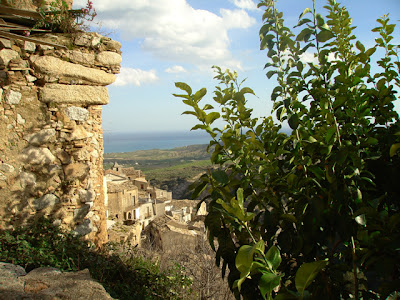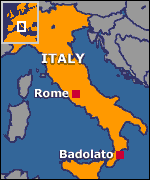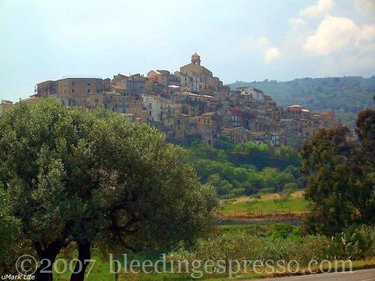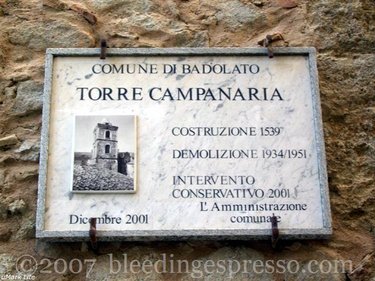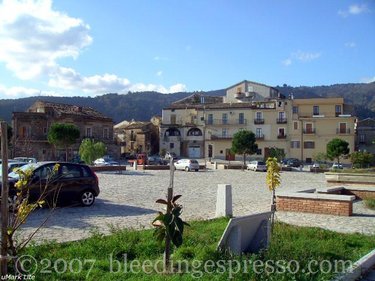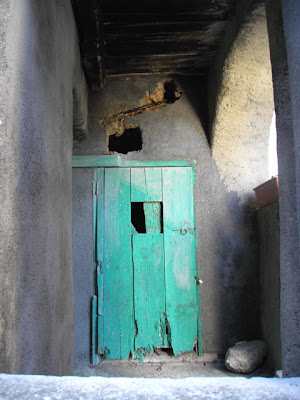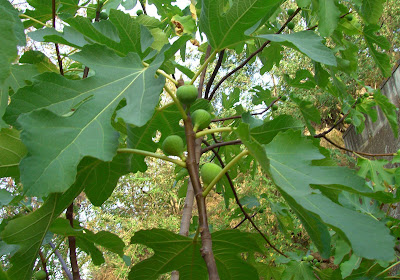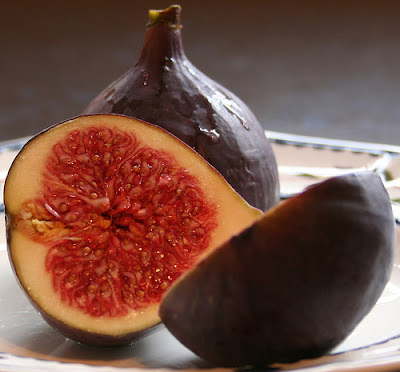Archive for the ‘scenes from village life’ Category
britney spears & shameless self-promotion
For some Friday fun, click here to read
5 Lessons Britney Spears Could Learn From a Tomato
as composed by none other than . . . me
(there’s the shameless self promotion part).
Come on. You know you’re dying to know what *that’s* all about.
And here’s another photo of my village from the archives.
Buon weekend y’all!
(That was for Brit.)
—————
[tags]britney spears, tomatoes, medieval villages, southern italy, calabria, badolato[/tags]
Badolato: Into The Heart of Calabria
Badolato Basics
My village, the birthplace of my great-great-grandfather, is Badolato, and it’s located between the Ionian Sea and the Serre Mountains in Calabria, the toe of Italy’s boot.
Badolato, the meaning of which is in dispute (sorry, only in Italian) was founded in 1080 by conqueror and first Duke of Calabria Robert Guiscard, who along with his brother, took over southern Italy and Sicily for the Normans around that time.
Like many villages of this period, Badolato was built on a hilltop about 5 kilometers from the sea with a good view of any approaching ships. Staying too close to the water was considered dangerous not only because of potential invasion–the southernmost part of the peninsula was the gateway to the entire territory now known as Italy and the rest of Europe–but also because of malaria, which was quite common as some of the area was swampland.
View of Badolato Superiore from the winding road leading up to the village.
And so, Badolato was built as a walled city, encircled by stone and guarded by three watchtowers, one of which is still partially standing (below); the town crest honors these watchtowers and the village’s medieval history.
Many of the original walls around the village as well as the old gates that sealed off the city from invaders also remain, but a castle on a hill that was once the town’s centerpiece (thus the name of the main square Piazza Castello) had to be torn down in the 1970s for safety reasons. Previously, it had cast a shadow on all that was below it, as castles are wont to do.
The piazza is now alternately called Piazza Fosso—fosso referring to the huge hole left behind by removing the hill and castle (it didn’t create a hole really, only leveled off the hill the castle had been on).
Political, social, and agricultural history
As rulers changed throughout southern Italy (German, French, Spanish, Turk, Austrian, Bourbon) Badolato felt each influence in turn, which you can hear in Badolatese, the main tongue spoken around here (a version of the Calabrian/Sicilian language, which some (mistakenly) call a dialect), and taste in the traditional Calabrian cuisine, noted for its fondness for the peperoncino, brought back to Italy by Columbus, although also widely used by Arabs who settled here.
Badolato soon became one of the most prominent and wealthiest cities in what is now southern Italy, swelling to a population of 8,000 (some estimates say up to 12,000) and boasting the palazzi of some of the most influential families in southern Europe, mostly due to production of olive oil, wine, and citrus fruit.
The family of the former baron of Badolato still owns a palazzo or two (although they don’t live here full-time) as well as a grand villa that sits on a huge chunk of the land surrounding the village. Almost all of the land around Badolato is still farmed, including that of the former baron, but most of it is was broken into smaller plots as the feudal system died down around the turn of the 20th century.
Incidentally, on the bigger plots, some families built workhouses (no plumbing, electricity, etc.), but still today it is rare for Calabrians to consider actually living on that kind of open land (most prefer village life and traveling by car or by foot to their land). Indeed getting permits to build is difficult as the land is zoned agricultural. Unless it has some existing structure (at least the remains of a wall!), it’s illegal to build a house on these land plots–which means no subdivisions in Calabria’s future. No complaints here.
Religious heritage
Badolato’s importance and deep religious and spiritual history are represented by its 13 churches and 17th century Convento Santa Maria degli Angeli, once a monastery but now a drug and alcohol rehabilitation treatment center; residents produce their own food on site and even operate a restaurant.
Convento nestled among olive trees
(You may remember this old monastery from the Easter procession)
Some say that it’s possible that the Holy Grail was transported here and may still be buried underground somewhere. In 1070, a group of Calabrian monks went to France and established the Ordre de Sion, which later became the Priory of Sion of Dan Brown’s Da Vinci Code fame–said to be the keepers of the Grail. The Calabrian monks returned to Calabria in 1090 but no one knows what, if anything, they brought with them from France; could they have incorporated valuable Christian artifacts into the underground ducts and tunnels of a blossoming Catholic stronghold called Badolato?
Effects of emigration
Like many southern Italian towns, Badolato was a victim of emigration, largely abandoned during two major waves of flight: the first in the early twentieth century (when my family left) and the second after World War II.
In both instances, emigrants were looking for better opportunities, but especially after the second World War when southern Italy was truly war-torn and downtrodden; my 82-year-old neighbor has sung for me a children’s rhyme that complained to Il Duce, Benito Mussolini, that they were living the day without bread and the night without lights (u jornu senza pane, la notte senza luce). A flash flood that wiped out a part of the village in the 1950s surely made the decision to leave easier for many.
Badolatesi fled to, among other places, the United States, Canada, Argentina, Brazil, Germany, Switzerland, and Australia, many leaving behind their homes with only whatever they could carry, never to return.
Others moved just down to the coast, where Badolato Marina was being built in the 1950s–living nearer to the water was now considered safe, plus coastal life was also more convenient with the railroad and highway running through there.
Indeed, P’s mom remembers where there wasn’t even a paved road leading down from the mountain village to the sea–I’ve yet to walk the path, but it’s still there–and anyway, there were only a handful of cars in the village even in to the 1960s, so you can that imagine folks tended to stay close to home.
Because of this mass emigration, the population of Badolato Superiore now stands at about 350 (total population with Badolato Marina is around 4000). This set-up is quite common throughout southern Italy, by the way, so that you’ll often see a “Superiore” town up on the hill/mountain, and its counterpart closer to the sea with “Marina” or “Lido” after the name.
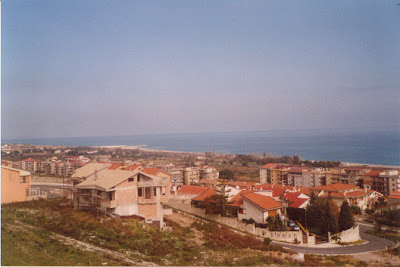 Badolato Marina
Badolato Marina
(Sorry for the poor quality here; it’s an old scanned photo of mine)
The Ship of Kurds
Badolato had fleeting hope of a boom just after Christmas 1997 when 825 Kurdish refugees landed on its shores; this made international news and you can read more about it here (the man on the left in the third photo is my vicino Giuseppe!).
The Badolato community welcomed the Kurds as potential workers and young revitalizers of the old town. The new immigrants are mostly gone now, though, either deported or having left for Germany, France, or elsewhere in the EU for work.
Still, Badolato remains one of the most involved immigration centers in all of Italy in so far as welcoming migrants and helping them with housing, health care, work, and psychological adjustment to life in a new country; one of my translation contracts with the local health care agency involves a special EU project to include cultural and linguistic mediators in this process.
Current and Future Badolato
And yet Badolato remains largely empty, like the village Farfallina wrote about, although the population swells enormously in August when many return to their hometown from Germany, northern Italy, etc., for ferie–Calabria, generally, is quite a hot spot for Italians and other Europeans looking for great, clean beaches.
Even the New York Times agrees.
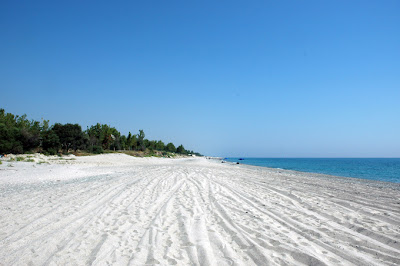 Photo © Franco Muìa
Photo © Franco Muìa
Badolato is undergoing a revitalization, though, as there have already been quite a few properties sold to international buyers over the years; casa by casa things are looking more lived in, although I’m the only year-round foreigner who lives here (Badolatesi would say the transplants from Genoa, Naples, and elsewhere in Italy are also stranieri, but I’m the only non-native Italian).
There is a lot of potential here for tourism, as you can probably imagine, although there would need to be a lot of infrastructure work done first–getting here and getting around isn’t always easy. No one wants to commercialize the town to the point that it’s another Siena or Cortona, overrun with tourists, but a few more visitors, a few more people who want to experience the real Italy complete with women carrying baskets on their heads?
Well that would be nice.
We may not have much support from the government, but we do have green mountains, a clear blue sea, fresh mountain air and water, warm souls, and delicious, fresh food, and for me, that’s certainly plenty.
Final Notes
For those of you who have made it this far (thank you!) and still want more, you can see more photos under the Scenes from Village Life label, my first Virtual Tour, and the two most recent posts: Destination Calabria: Photo Tour of a Medieval Village (Part I) and (Part II).
And if you want to plan a trip, just let me know!
destination calabria:photo tour of a medieval village (part II)
We left off yesterday with a glance back at one of the abandoned parts of my village, and now it’s time to delve even deeper.
Here’s where we were.
This is one of the original walls of the village that used to protect from invasions of pirates and the like.
And here’s another angle of the same wall, which you can tell from the flowers growing out of it (remember, this was May when the photos were taken).
The big crack down the middle? Earthquake damage from at least the 1950s, but probably before then even as this area has been hit with quite a few big ones–the city of Reggio Calabria was leveled in 1908.
The village was also the victim of an alluvione, a flash flood that caused a mudslide, wiping off a good chunk of the village–that’s the part we’ve been walking through, and now we’re in a section that, although didn’t wash away, was where a lot of those houses landed.
The village is situated up on a hill, which means a lot of steep inclines and declines, right Cherrye? This is a small one:
And although this entire section of the village is completely abandoned, there are still some chickens, pigs, goats, etc., kept down here. And other stuff.
If you keep walking, you’ll eventually get to the lowest church in the village, Chiesa della Provvidenza, built in 1598, which puts her in the younger half of the thirteen churches in the village.
She’s also one of my favorites because the town celebrates la Madonna di Provvidenza on the first Sunday in July–which means that every year, there’s a cook-out and fireworks at least sometime around the 4th of July, which is nice for this American.
Plus the church kind of reminds me of a gingerbread house, and they always make me smile.
On the left side of the above photo, do you see the small wooden cross that looks like it was built to face the church? I couldn’t resist taking a closer look.
I’m not sure if there is any special significance, but I do know that there was a tragic accident near there many years ago involving young children playing with explosives they found; as legend goes, after World War II, many soldiers literally dropped their weapons and ammunition where they were standing when they heard the war was over, and every now and again, there is word of someone finding something from that time period.
P tells me there were some explosives that resembled sardine cans with a peel-back lid, so one could see how children might get curious.
And this is where Luna lost all patience and ran off towards home without me. Photo tour cut short on that lovely Sunday morning in May.
I hope to take another one soon, though, and I’ll be sure to share what I see.
On yesterday’s post, there were a few questions in the comments regarding the state of the village, how it got this way, what’s happening now, etc., and I promise to answer them all in due time. It’ll require preparing a short yet interesting history lesson, which I promise to work on over the weekend if you promise to come back to learn.
Would it help if I guarantee a mention of the Holy Grail?
—————
[tags]calabria, medieval villages, southern italy, badolato[/tags]
destination calabria:photo tour of a medieval village in southern italy (part I)
It’s been a while since I’ve posted some photos, and I think it’s time. I’m still camera-less, but I do have some shots stored away, so let’s go back to a lovely day in May when Luna and I took a walking tour around a section of the village.
It all started out in the little piazza near my house where the main church is located; truth be told, I hadn’t even brought my camera but then I saw these:
So I went back home and grabbed the macchina fotografica. I don’t know how these roses ended up there, but it’s certainly not uncommon to find flowers outside the church in the morning.
By the way, we have 13 churches here in all (reminder: 300 people), but only one operates full time. I promise to write more about the history of the village at some point and how it’s been largely abandoned (inspired by Farfallina!) but until I can get more photos to accompany it, we’ll just have to stick with what I’ve got.
Here’s the bell tower of La Chiesa Matrice/La Chiesa di San Salvatore, built in 1218.
After we wound down one of the winding streets, I saw this cactus giving a helping hand to a piece of fallen fruit:
The fruit is a fico d’india (Indian fig) aka prickly pear. I’m not quite sure why the one in the grip of the cactus is ripe when none of the others are–and actually I’m not sure why that one is ripe at all.
Remember this was May, and their season is now (sorry I can’t get a good photo for you Gil, but do check out Sara’s post!), so that coddled one sure was special.
Moving on. . . .
Sorry, but there’s really nothing else behind there except this:
No one (human) lives in this part of the village, and so much of it is falling down, boarded up, and otherwise abandoned-looking.
Here is my very favorite abandoned house.
If you peek in through the crack in the front door, you can see la famiglia gathered inside the small room on the first chilly night of the year:
La Mamma stirring the sugo one last time before getting the water ready for pasta, resting the wooden spoon on the side of the terra cotta pot, and wiping her hands on her well-worn but clean apron.
La figlia embroidering sheets in preparation of her upcoming matrimonio, pulling the thread up through the fabric and back down, over and over, her feet resting on the old braciere.
Il figliolo and Papà playing briscola in another corner, their many layers of clothes making each throw of a card less dramatic than it normally would be.
[I may or may not have spent many hours sitting near this house over the past four years.]
But back to 2007, and back to greenery, which is just around the corner.
Can you find Luna?
And finally, a quick glance back at where we’ve been before we move on.
Won’t you come back and continue our passeggiata?
—————
[tags]calabria, southern italy, badolato, medieval villages, dogs[/tags]
what’s cooking wednesday: figs, figs, figs
A long time ago, when I asked all of you to ask me questions to fill out JennieBoo‘s eight things meme,* Amanda of the always delicious Figs Olives Wine kept it short and sweet:
The most delicious thing you’ve eaten in Calabria. Something that just blew you away when you tasted it.
As it turns out, my answer is also short and sweet, literally.
The fresh fig.
These are some green ones, not quite ripe yet, on our fig tree taken about a month and a half ago (in one of the last photos of my injured camera).
Don’t you just love the shape of fig leaves? I hear Adam and Eve sure did. Hah!
And here is a much better, nay awesome photo of the “black” variety, which I found through a Flickr search and am using here under a Creative Commons license (great way to *legally* use others’ pretty photos! Notice I did this on the Spaghetti Strike post as well):
Click here or on the photo to go and see more photos by Xerones–fabulous. Leave him some comments and let him know I sent you.
But back to the figs, did you know that the fig is one of the first plants cultivated by humans? And they’re good for you too!
I had never eaten a fresh fig before I came here, and man oh man, I had no idea what I was missing. This little seedy (in a good way) fruit is by far my new favorite anything–and like Amanda, I prefer it fresh to any other way.
So that’s my first serving suggestion for figs on this What’s Cooking Wednesday.
How do I eat them? Like P taught me. Cut a cross in the top (the end that used to be connected to the tree) and then peel back the skin one part at a time with the edge of the knife. It’ll come back easily if they’re ripe enough–just do be sure to eat them within a day or two of picking them off the tree. They won’t last much longer than that.
Next, I’m going to point you to my second favorite way to eat figs aside from plain with the juice running down my fingers, and that’s with prosciutto crudo.
Jenn, also known as The Leftover Queen and founder of The Foodie Blogroll, has a great description of this dish here. I was setting up a photo of this about a month ago when I realized my camera was dead, so this is a bit of an emotional plate for me now, but I still love it.
Judy of Over a Tuscan Stove and the Divina Cucina Cooking School in Florence also recommends pairing figs with salami–something I’ve never tried, but sounds tasty as well.
And last but certainly not least, I’m going to go back to the inspiration for this post, Amanda, and send you to her Fresh Figs with Fleur de Sel, Aged Balsamic, and Hazelnuts, which she put up just yesterday, reading my mind on what I was going to talk about today.
So, the fresh fig. Simple, delicious, and quite honestly one of the best things I’ve ever eaten in Calabria or anywhere. I also like them dried and in jams, but fresh? Just. Wow.
Doesn’t need to be complicated to be good folks, so even if figs aren’t your thing or you can’t manage to get them, do try to eat lots of other fresh fruits while they’re still in season.
Pair them with flavors you think would complement one another–sweet and salty is always a good bet. Pears and gorgonzola? Apples and cheddar? Grapes and Parmesan?
Be creative, have fun, and keep an open mind!
You never know when your next favorite food combination could show up.
Buon appetito!
*[For those just joining us, feel free to go back and read parts 1, 2, 3, and 4 of the answers to the questions that were asked.]
—————
[tags]figs, what’s cooking wednesday, figs and prosciutto crudo[/tags]

